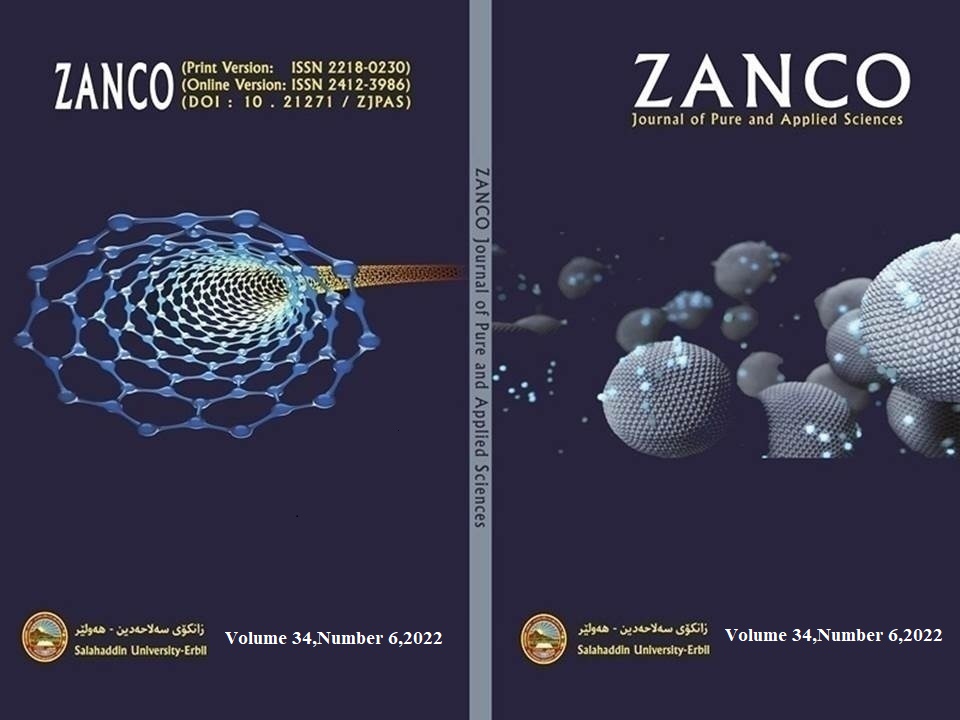Properties of Oil Extracts from Local Sesame Seeds (Sesamum Indicum L.)
DOI:
https://doi.org/10.21271/ZJPAS.34.6.16Keywords:
Local sesame seed, physicochemical properties, sieving size, sesame oil extraction.Abstract
This study was conducted to determine the main physiochemical properties of sesame oil extracted from three sesame seeds samples, the differences between mixed (A-C) and the sieved sesame seed (A1-C3): which were taken from Sharzoor in Sulaymaniyah (S, mixed brown), Akre in Duhok (A, mixed brown) and Mala Omar in Hawler (MO, mixed brown). And to evaluate the differences between the OIL characteristics of mixed (Akre ,A, Sharzoor B, Mala Omar ,C ) and the sieved seeds with three different mesh size sieve (1.50, 1.35, 1) mm included (A1,A2,A3,.B1,B2,B3 ,C1,C2 and C3). The properties that included to study in this work were viscosity, specific gravity, fatty acid content, acid value, iodine value, and peroxide value. From the results of this study, it was found that the Mala Omar sample in all parts especially C2 48.42% is considered good source for oil, the viscosity of (hawler) samples especially C3 with 0.0490 Pas, the lowest viscosity while the A1 has a maximum viscosity 0.0525 Pas. More than 80% of sesame seeds' fatty acid composition is unsaturated, with high concentrations of oleic, linoleic, and lenolinic acids. Saturated fatty acids, primarily palmitic and stearic acids, account for the remaining 20%. Acid value in sample A1 of sharazoor sesame oil had the lowest content (2.1030 mg KoH\gm oil), whereas sample C3 had the greatest concentration. Omar Mala 15.5815. A3 sharazoor sample a higher 11.4954 gm I2\100gm oil, iodine value. While the maximum peroxide value was found in the B3 sesame oil sample of 15.9267 meq/kg, and the lowest peroxide value was found in the B sesame oil sample at 3.8850 meq/kg.
References
Agriculture statistics department, (2014). Summer Crops agricultural report Planting year 2013
AOAC., (1995). Official methods of analysis 16th edition. Association of official analytical chemists. Washington, DC, USA.
AOAC (2005) Official Methods of Analysis of the Association of Analytical Chemists. 18th Ed. Gaithersburg, MD, USA., ISBN-13: 978-0935584752
Baker, B.P. and Grant, J.A., 2018. Sesame & Sesame Oil Profile.
BORCHANI, C., BESBES, S., BLECKER, C.H. & ATTIA, H., (2010). Chemical characteristics and oxidative stability of sesame seed, sesame paste, and olive oils. Journal of Agricultural Science and Technology, 12(5),585-596.
BROSK F. A. ZANGANA, (2013). Experiment No. 2: Density and Specific Gravity (Hydrometer).
CHAKRABORTY, D., DAS, J., DAS, P.K., BHATTACHARJEE, S.C. & DAS, S., 2017. Evaluation of the parameters affecting the extraction of sesame oil from sesame (Sesamum indicum L.) seed using soxhlet apparatus. International Food Research Journal, 24(691-695.).
DEVARAJAN, S., SINGH, R., CHATTERJEE, B., ZHANG, B. & ALI, A., (2016). A blend of sesame oil and rice bran oil lowers blood pressure and improves the lipid profile in mild-to-moderate hypertensive patients. Journal of clinical lipidology, 10(2),339-349.
DIAMANTE, L.M. & LAN, T., (2014). Absolute viscosities of vegetable oils at different temperatures and shear rate range of 64.5 to 4835 s− 1. Journal of food processing 2014:1-6.
EMIL, A., YAAKOB, Z., SATHEESH KUMAR, M.N., JAHIM, J.M. & SALIMON, J. (2010) Comparative evaluation of physicochemical properties of jatropha seed oil from Malaysia, Indonesia and Thailand. Journal of the American Oil Chemists' Society. 87 (6). 689-695.
GHARBY, S., HARHAR, H., BOUZOUBAA, Z., ASDADI, A., EL YADINI, A. & CHARROUF, Z., (2017). Chemical characterization and oxidative stability of seeds and oil of sesame grown in Morocco. Journal of the Saudi Society of Agricultural Sciences, 16(2), pp.105-111.
HASSAN, M.A., (2012). Studies on Egyptian sesame seeds (Sesamum indicum L.) and its products 1-physicochemical analysis and phenolic acids of roasted Egyptian sesame seeds (Sesamum indicum L.). World Journal of Dairy & Food Sciences, 7(2), 195-201.
HOJJATI, M., NOGUERA-ARTIAGA, L., WOJDYLO, A. & CARBONELL-BARRACHINA, A.A. (2015). Effects of microwave roasting on physicochemical properties of pistachios (Pistaciavera L.). Food science and biotechnology. 24 (6).1995-2001.
Kamal-Eldin, A. and Appelqvist, L. A. 1995. The effects of extraction methods on sesame oil stability. Journal of the American Oil Chemists’ Society 72(8): 967-969.
Lichtenstein, A. H. and Deckelbaum, R. J. 2001. Stanol/sterol ester–containing foods and blood cholesterol levels: A statement for healthcare professionals from the nutrition committee of the council on nutrition, physical activity, and metabolism of the American heart association. Circulation 103(8): 1177-1179.
ORSAVOVA, J., MISURCOVA, L., AMBROZOVA, J.V., VICHA, R. & MLCEK, J., (2015). Fatty acids composition of vegetable oils and its contribution to dietary energy intake and dependence of cardiovascular mortality on dietary intake of fatty acids. International journal of molecular sciences, 16(6): 12871-12890.
PARTHASARATHY, U., NANDAKISHORE, O.P., SENTHIL KUMAR, R. & PARTHASARATHY, V.A., (2014). A comparison on the physico-chemical parameters of seedbutters of selected Indian garcinia spp.
RAHMAN, M.S., HOSSAIN, M.A., AHMED, G.M. & UDDIN, M.M., (2007). Studies on the characterization, lipids and glyceride compositions of Sesame (Sesamum indicum linn.) Seed Oil. Bangladesh Journal of Scientific and Industrial Research, 42(1): 67-74.
Book, G., (2005). Ministry of Agriculture and Land Reclamation. Economic Affairs Sector, Central Administration for Economic.Visavadiya, N. P., Soni, B. and Dalwadi, N. 2009. Free radical scavenging and antiatherogenic activities of Sesamum indicum seed extracts in chemical and biological model systems. Food and chemical toxicology 47(10): 2507-2515.
Zhang, H., Wang, Z. and Liu, O., (2015). Development and validation of a GC–FID method for quantitative analysis of oleic acid and related fatty acids. Journal of Pharmaceutical Analysis, 5(4): 223-230.
Downloads
Published
How to Cite
Issue
Section
License
Copyright (c) 2023 Sheraz Zuher Karem , Safea Sabir Taha

This work is licensed under a Creative Commons Attribution 4.0 International License.














